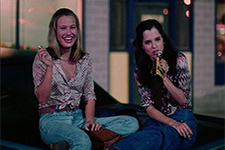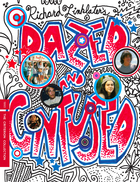Dazed and Confused (4K UHD)
|  Richard Linklater’s Dazed and Confused gets the details right. In fact, one could argue that the film is primarily, if not completely, about its details. It has a narrative—or, rather, it has many narratives, all of which take place entirely during the afternoon and night of the last day of school in a small town in 1976. Yet, the film’s richness, what brings you back to it again and again, is Linklater’s spot-on observations about the rituals of teenage life and his attention to the smallest nuances of time and place. Linklater was himself a product of the 1970s, and he views the era not with the ironic disdain of a posturing postmodernist, but rather with the keen eye of an anthropologist. He understands and conveys the awkwardness of late-night first kisses, the silliness of eighth-grade slow dances, and the dizzy stupor of being drunk for the first time. He packs the frame with images that convey so much about his characters’ lives—the girl having the zipper on her skin-tight jeans pulled up by a friend with pliers, the way adolescent guys use the crudest vulgarities as terms of endearment, and the way teenagers cruise up and down the town’s main drag and always respond to the question “What’s going on?” with “Nothin’ much.” He observes the details of bathroom graffiti, the contrasting styles of male and female hazing, and the pathetic, wheezy noise a keg tap makes when it’s finally empty. Yet, despite being an almost perfect time capsule, Dazed and Confused is not a one-note slice of sentimental nostalgia. In fact, Linklater has said that he did not want the film to be nostalgic—to be a view of the 1970s from the 1990s. Rather, he wanted it to look and feel like a film that was made in 1976, and in this respect, he is entirely successful. There is never a hint of revisiting the past, but rather a sense of continuity. The more things change, the more they stay the same. The film opens with a now-famous slow-motion shot of an orange Pontiac GTO cruising the high school parking lot to the opening chorus of Aerosmith’s “Sweet Emotion,” the first of many perfect marriages of sound and image. Not surprisingly, what many people remember and cherish about Dazed and Confused is the way it is fueled by its soundtrack. Again and again Linklater finds perfect period rock music to underscore the action. Sometimes it is amusingly obvious, such as his use of Alice Cooper’s “School’s Out” as students empty their lockers and bolt from the school as the bell rings; sometimes it is ironic, such as his use of War’s “Why Can’t We Be Friends” as senior girls haze the incoming freshmen girls; and sometimes it is just perfect, such as the film’s final fade-out image of a rolling highway to the tune of Foghat’s “Slow Ride.” Having established his visual and aural canvas in the first shot, Linklater then introduces us to his universe of characters, which span the spectrum of teenage life. The center is held by Randy “Pink” Floyd (Jason London), the high school quarterback. Randy is the center because he associates with virtually everyone in the high school. His friends include not only other members of the football team, especially the hyper-horny jock Don Dawson (Sasha Jenson), but also free-wheeling slackers such as Slater (Rory Cochrane), whose perpetually high state embodies the film’s title. He is also friends with the school’s smart kids, particularly Mike Newhouse (Adam Goldberg) and Tony Olson (Anthony Rapp), whose specific brand of ironic detachment and sociological sharpness is completely wasted on most high school students. One of the primary misunderstandings of Dazed and Confused is that it celebrates characters who do nothing with their lives. In fact, the film differs sharply from most teen comedies in the way it observes and underscores the failure of those characters who never mature. This is embodied primarily in Fred O’Bannion (Ben Affleck), a returning senior who takes particularly sadistic pleasure in dishing out the painful hazing ritual of paddling to incoming freshmen. He is the film’s bully, but he is also the film’s joke because his single-minded cruelty is made possible only by the fact that he failed his senior year of high school. We can see this in David Wooderson, as well, who is played with impeccable comedic pitch by Matthew McConaughey in his feature debut. Wooderson, who graduated two years earlier but still hangs out with high school kids, is a textbook case of arrested development. Having achieved his high point in life in his teens, he refuses to exit the building; he remains top dog by hanging on to that which others grow out of. His line about his love of high school girls—he gets older while they stay the same age—is both hilarious and creepy. In his own mind, Wooderson is a king, but like O’Bannion, he is also a joke. On the other hand, we have Randy, who is having a personal crisis because his coach wants him to sign a form pledging not to drink or do drugs or engage in any activity that might jeopardize his commitment to being on a state championship team. Everyone else is signing the pledge and then disregarding it, but Randy can’t get past the hypocrisy of it. Thus, despite being a teenager who does typically inane adolescent things, he has a deeper maturity and sees the world in a way many of his friends do not (he also has a meaningful sense of empathy, which we see in his relationship with an incoming freshman whom the other seniors have made their primary target for torture). Dazed and Confused was Linklater’s third feature film, but his first for a major studio with a multi-million-dollar budget. At the time, he was known primarily for Slacker (1991), an ultra-low-budget indie in which dozens of intriguing denizens on the social margins of Austin, Texas, interacted through a sprawling web of interlocking narratives. Like his protagonist Randy, Linklater was in something of a bind in producing Dazed: He had been given the keys to the kingdom, so to speak, by the studio, yet he was intent on doing the film his way. By most measures, the production was a mess (constant pressure from the studio, shortened production time, etc.), but it wasn’t enough to curb the energy and vitality that Linklater and his young, almost entirely unknown cast brought to the film (not surprisingly, the casting director was Don Phillips, who also brought together an incredible, then-unknown cast 10 years earlier for Fast Times at Ridgemont High [1982]). The cast’s lack of experience mostly plays well on the screen; there is an inherent naturalness to the fresh-faced ensemble, although it sometimes slips into amateurishness (Wiley Wiggins, who plays the eighth grader whom Randy befriends, is a very self-conscious actor who is rarely convincing when he needs to be). Two decades after it was made, Dazed and Confused plays exactly as it did in 1993, which is its greatest strength. Its acute sense of time and place and the way characters interact with each other never fades or becomes dated. Linklater set out to make a film that was, in its own way, timeless, and the passing of years has only reinforced his against-the-odds success.
Copyright © 2023 James Kendrick Thoughts? E-mail James Kendrick All images copyright © The Criterion Collection / Universal Pictures Home Entertainment | |||||||||||||||||||||||||||||
Overall Rating: 


 (3.5)
(3.5)


